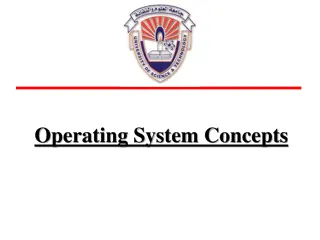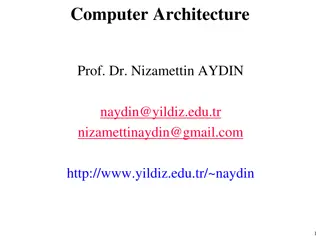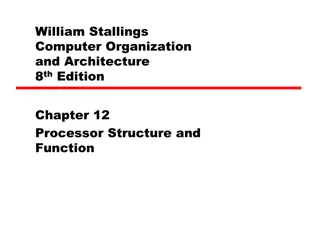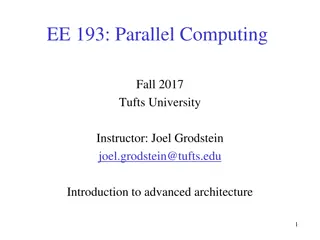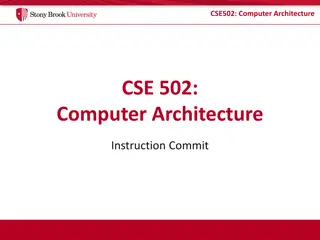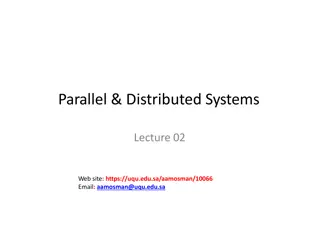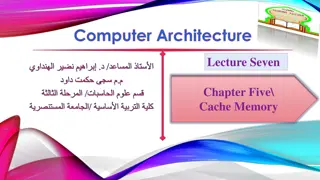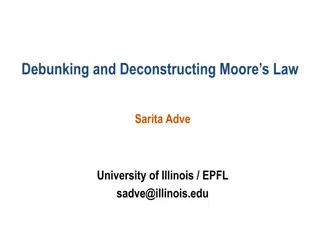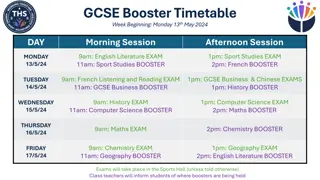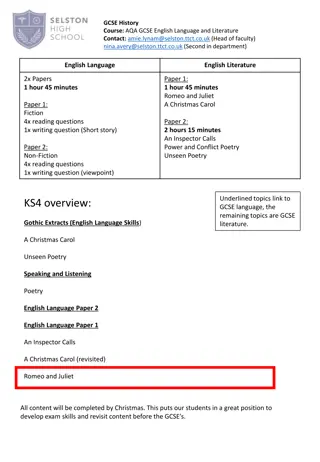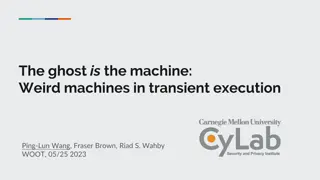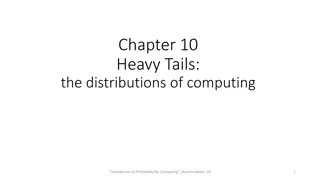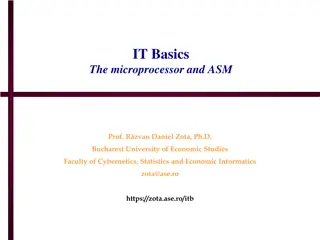Understanding CPU Architecture in Computing for GCSE Students
Explore the fundamental concepts of CPU architecture, including the Von Neumann Architecture, common CPU components like ALU and CU, and how characteristics such as Clock Speed and Cache Size impact performance. Learn about the Fetch-Execute Cycle and the essential hardware components of a computer system. Discover the role of the CPU in executing program instructions and the stored program concept.
Download Presentation

Please find below an Image/Link to download the presentation.
The content on the website is provided AS IS for your information and personal use only. It may not be sold, licensed, or shared on other websites without obtaining consent from the author. Download presentation by click this link. If you encounter any issues during the download, it is possible that the publisher has removed the file from their server.
E N D
Presentation Transcript
Teaching Computing to GCSE Session 3 Theory: CPU Architecture Practical: 1 & 2D Arrays/Lists
Specification Content OCR The purpose of the CPU Von Neumann Architecture: MAR, MDR, Program Counter, Accumulator Common CPU components and their function: ALU, CU, Cache The function of the CPU as fetch and execute instructions stored in memory How common characteristics of CPUs affect their performance: Clock Speed, Cache Size, Number of Cores AQA Explain the Von Neumann Architecture Explain the role and operation of main memory and following major components of a CPU: ALU, CU, Clock, Bus Explain the effect of the following on the performance of the CPU: Clock Speed, Number of Cores, Cache Size, Cache Type Understand and explain the Fetch-Execute Cycle Edexcel Understand the function of the hardware components of a computer system (CPU, main memory, secondary storage, input and output devices) and how they work together. Understand the concept of a stored program and the role of the components of the CPU (CU, ALU, Registers, Clock, Buses) in the fetch- execute-decode cycle.
The CPU The CPU or Central Processing Unit is responsible for carrying out the instructions that make up computer programs.
Stored Program Concept The program instructions for the first computers were stored on punched tape, which had to be fed into the computer when needed. Later the computers were developed that stored instructions electronically in internal memory. This is known as the stored program concept.
CPU Components Manages execution of instructions by sending control signals to other parts of the CPU. Control Unit Main Memory Registers Wires that are used to transfer data between components. Temporary storage locations within the CPU. Arithmetic and Logic Unit carries out arithmetic and logical operations. ALU
Registers PC Program Counter holds the memory address of the next instruction. Control Unit Memory Address Register holds the memory address of either the next piece of data to be read or the next instruction. MAR Main Memory ACC Accumulator holds the results of calculations carried out by the ALU MDR Memory Data Register holds the data or instruction retrieved from main memory. ALU
Activity 1 There are three different buses that are used to transfer different types of data between components. Use the descriptions in the notes section at the bottom of this slide to complete the table. Bus Description Address Bus Data Bus Control Bus
Fetch-Execute Cycle As soon as a computer is turned on it starts fetching instructions from memory, decoding them and executing them. This process is repeated continuously, therefore it is known as the Fetch- Execute Cycle. Fetch Execute Decode
Fetch-Execute Cycle Example Address Data 0 0 1 PC 0 ADD 4 ADD 4 Control Unit Address Bus 0 0 MAR 1 Main Memory ACC 2 Control Bus Data Bus MDR ADD 4 3 4 ALU 4
Activity 2 Place the stages of the fetch-execute cycle in the correct order: The instruction is decoded. The decoded instruction is executed. The Program Counter is incremented. The address of the next instruction to be fetched is place in the MAR. The instruction is fetched from memory and placed in the MDR.
Von Neumann Architecture In 1945 John Von Neumann described a model for a stored program computer that became known as the Von Neumann Architecture. The CPUs in most modern computers are based on this architecture. It uses one memory for both data and instructions. It executes one instruction at a time using the fetch-execute cycle. Control Unit Registers Main Memory ALU
Cache Cache is special type of fast memory that sits between the CPU and Main Memory. It is used to store frequently used data and instructions, this saves the CPU having to repeatedly access Main Memory. This can improve performance as it is quicker to access Cache than to access Main Memory.
Cache Levels Control Unit Main Memory between the CPU and Main Memory, slower and larger than L1. Registers L2 / L3 Cache Level 2 and 3 Cache sits L1 Level 1 Cache inside the CPU, fastest but also smallest. Cache ALU
Cores Modern CPUs feature multiple processing units (cores) on the same chip. This enables CPUs to carry out multiple instructions at the same time (one per core). Core 1 Core 2 Core 3 Core 4
Activity 3 This table is designed to summarise the factors that impact on CPU performance, complete it using the text in the notes section. Clock Speed Cache Size Number of Cores
Activity 4 Answer this exam question: Ann wants to purchase a new computer and is looking at two models. The specification of the CPU in each computer is shown in Fig. 1. When running a 3D flight simulator, Computer 1 is likely to run faster than Computer 2. Using the information in Fig. 1, identify one reason for this. (1) Source: OCR GCSE Computer Science (9-1) Component 1 Sample Paper
Activity 5 Answer these exam questions: Explain one reason why the cache size affects the performance of the CPU. (2) Identify four events that take place during the fetch-execute cycle. (4) Source: OCR GCSE Computer Science (9-1) Component 1 Sample Paper
Break After the break we will look at 1 and 2D Arrays / Lists.


